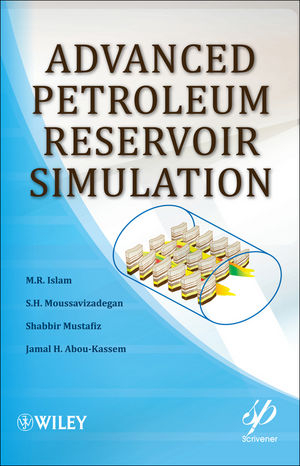
Advanced Petroleum Reservoir Simulation
John Wiley & Sons Ltd (Verlag)
978-0-470-62581-1 (ISBN)
- Titel ist leider vergriffen;
keine Neuauflage - Artikel merken
* Includes companion software with 3-D, 3-phase multipurpose simulator code available for download from www.scrivenerpublishing.com. * By providing a valuable tool to support reservoir simulation predictions with real science, this book is an essential reference for engineers, scientists and geologists.
M. R. Islam, PhD, is Professor of Petroleum Engineering at the Civil and Resource Engineering Department of Dalhousie University, Canada. He has over 700 publications to his credit, including 6 books. He is on the editorial boards of several scholarly journals, and, in addition to his teaching duties, he is also director of Emertec Research and Development Ltd. and has been on the boards of a number of companies in North America and overseas. S. Hossein Mousavizadegan, PhD, is currently on the faculty of marine technology at the Amirkabir University of Technology in Tehran as an assistant professor, specializing in mathematical and numerical modeling of fluid dynamics. Shabbir Mustafiz, PhD, is a research engineer with the Alberta Research Council in Edmonton, Canada. Shabbir has published over 25 journal articles and has a Ph.D. in Civil Engineering, on the topic of petroleum reservoir simulation, from Dalhousie University and he is the current SPE Scholarship Chair for the Edmonton Section. Jamal H. Abou-Kassem, PhD, is Professor of Petroleum Engineering at the United Arab Emirates University, where he has taught since 1993. Abou-Kassem is a coauthor of two textbooks on reservoir simulation and an author or coauthor of numerous technical articles in the areas of reservoir simulation and other petroleum and natural gas-related topics.
Foreword. Introduction. 1. Reservoir Simulation Background. 1.1 Essence of Reservoir Simulation. 1.2 Assumptions Behind Various Modeling Approaches. 1.3 Material Balance Equation. 1.4 Recent Advances in Reservoir Simulation. 1.5 Future Challenges in Reservoir Simulation. 1.6 Economic Models Based on Futuristic Energy Pricing Policies. 1.7 Integrated System of Monitoring, Environmental Impact and Economics. 2. Reservoir Simulator-input/output. 2.1 Input and Output Data. 2.2 Geological and Geophysical Modeling. 2.3 Reservoir Characterization. 2.4 Upscaling. 2.5 Pressure/Production data. 2.6 Reservoir Simulator Output. 2.7 History-matching. 2.8 Real-time Monitoring. 3. Reservoir Simulators: Problems, Shortcomings, and Some Solution Techniques. 3.1 Multiple Solutions in Natural Phenomena. 3.2 Adomian Decomposition. 3.3 Some Remarks on Multiple Solutions. 4. Mathematical Formulation of Reservoir Simulation Problems. 4.1 Black Oil Model and Compositional Model. 4.2 General Purpose Compositional Model. 4.3 Simplification of the General Compositional Model. 4.4 Some Examples in Application of the General Compositional Model. 5. The Compositional Simulator Using the Engineering Approach. 5.1 Finite Control Volume Method. 5.2 Uniform Temperature Reservoir Compositional Flow Equations in a 1-D Domain. 5.3 Compositional Mass Balance Equation in a Multidimensional Domain. 5.4 Variable Temperature Reservoir Compositional Flow Equations. 5.5 Solution Method. 5.6 The Effects of Linearization. 6. A Comprehensive Material Balance Equation for Oil Recovery. 6.1 Background. 6.2 Permeability Alteration. 6.3 Porosity Alteration. 6.4 Pore Volume Change. 6.5 A Comprehensive MBE with Memory for Cumulative Oil Recovery. 6.6 Numerical Simulation. 6.7 Appendix 6A: Development of an MBE for a Compressible Undersaturated Oil Reservoir. 7. Modeling Viscous Fingering During Miscible Displacement in a Reservoir. 7.1 Improvement of the Numerical Scheme. 7.2 Application of the New Numerical Scheme to Viscous Fingering. 8. Towards Modeling Knowledge and Sustainable Petroleum Production. 8.1 Essence of Knowledge, Science, and Emulation. 8.2 The Knowledge Dimension. 8.3 Examples of Linearization and Linear Thinking. 8.4 The Single-Parameter Criterion. 8.5 The Conservation of Mass and Energy. 8.6 The Criterion: The Switch that Determines the Direction at a Bifurcation Point. 8.7 The Need for Multidimensional Study. 8.8 Assessing the Overall Performance of a Process. 8.9 Implications of Knowledge-Based Analysis. 8.10 Examples of Knowledge-Based Simulation. 9. Final Conclusions. Appendix A User s Manual for Multi-Purpose Simulator for Field Applications (MPSFFA, Version 1-15). A.1 Introduction. A.2 The Simulator. A.3 Data File Preparation. A.4 Description of Variables Used in Preparing a Data File. A.5 Instructions to Run Simulator and Graphic Post Processor on PC. A.6 Limitations Imposed on the Compiled Versions. A.7 Example of a Prepared Data File. References. Index.
| Reihe/Serie | Wiley-Scrivener |
|---|---|
| Zusatzinfo | Illustrations |
| Verlagsort | Chichester |
| Sprache | englisch |
| Maße | 165 x 244 mm |
| Gewicht | 842 g |
| Themenwelt | Naturwissenschaften ► Chemie |
| Technik ► Elektrotechnik / Energietechnik | |
| ISBN-10 | 0-470-62581-3 / 0470625813 |
| ISBN-13 | 978-0-470-62581-1 / 9780470625811 |
| Zustand | Neuware |
| Haben Sie eine Frage zum Produkt? |
aus dem Bereich



